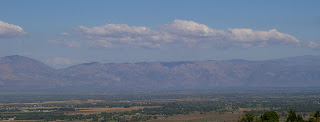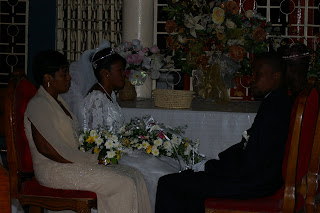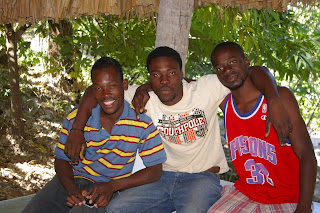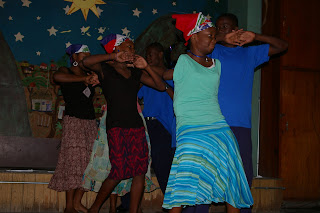
I spent the four nights and three days preceding Christmas Eve in Gwo Jan, a blissful community about 45 minutes outside of Port au Prince. It is located near the town of Pernier, particularly known for the Battle of Pernier during the fight for independance. In the days of slavery, this area was probably a refuge for runaways or “marron”. I stayed on the property of N A Sonje Foundation (nasonje.blogspot.com), a non-profit whose mission is to raise and deepen awareness of the rich history of Haiti. They do this in many forms- guided tours, lectures, drama and interactive programming. The primary reason for my stay was to begin studying Kreyol intensively. The pace of my schedule in the first seven weeks of my residency had not really allowed time for me to learn Kreyol. I had patched French phrases together to try to communicate my thoughts, but really had no comprehension or ability in Kreyol. With the seminarians on Christmas vacation, this was the perfect time to have an immersion experience.
Before sharing the details of my experience, you may be interested in learning a little bit about the origin of Kreyol. When the French arrived in Haiti, the original Native American population, under the brutal oppression of the Spanish, had been decimated through suicide, unconscionable labor, cruel punishment and disease. The French travelled to West Africa, captured Africans and brought them back to Haiti to serve as slaves. Kreyol was formed out of the West African dialects and French. Though it has never been declared as the official language, it is truly the common language of Haiti or “Ayiti”.
I had learned of N A Sonje Foundation through a colleague at BuildaBridge. I had been corresponding with Carla for months, inspired by the mission and vision of their work. She showed up at the Diaspora of Hope training and was responsible for Mona joining the team. Following the art camp, the U.S. members of the Diaspora team visited the N A Sonje property. Though a whirlwind tour, we were completely taken by the beauty and tranquility of the land. In addition, we were graced with a mini concert by Carla’s band. Carla plays violin, her husband Ron, Levy, Nja and Mona on guitar and Welele on drums. They write their own music. The message is usually specific to tradition and circumstance in Haiti- very powerful and beautifully composed. I felt as though I had found place where I could learn the truth about Haiti in a retreat-like setting. I knew I would be back.



My immersion experience started on Saturday night at the wedding of the Goddaughter of Carla’s partner, Ari. We then headed up through the hills to Gwo Jan. We had a late supper followed by a band rehearsal. The added treat for me was that Mona’s daughter, Natalie, was also visiting. She laid her head on my lap and fell asleep during practice. After practice, we chatted a bit and then everyone headed off to bed.

The routine for the next three days would be the same- up at 6 a.m., breakfast at 7 a.m.; common phrases, vocabulary and grammar at 7:30 a.m., being joined by young adults from the community- Emmanuel, Williamson and Woodson; 10 a.m.-3 p.m. visiting neighbors and touring the area with Emmanuel, Williamson and Woodson to put Kreyol into use; 3 p.m. lunch; 4-6 p.m. break; and supper and informal personal and cultural discussion with Carla, Ron and, sometimes, Ari. Slowly but surely, I found that some basic questions and responses were coming more easily. My comprehension was definitely improving. It was also really nice to have this work married with a broader understanding of the history and culture of Haiti and new friendships in the community.

One of the most meaningful community visits that we made was to the home of Monavwa, an elder in Gwo Jon. He has been failing for some time and Carla had not had a chance to see him recently. Three generations of the family live together, the newest member of which is a three-month old baby named Kenya. We greeted all the family members in the yard and then proceeded into the house. Monavwa was laying in a bed of crisp, white linens. Though this was the first time that I had met him, it was clear that he was quite frail. He was also having a difficult time breathing. While we were visiting, one of his daughters brought in Kenya. I opened my hands toward her and she willingly passed him to me. What a joy! He was fine until he realized that he had only been partially fed. I took him to his mother so he could finish eating. He fell asleep and she placed him next to his grandfather, in the exact same position. I had stayed outside. When Carla saw how Kenya’s mother placed him, she called me in and asked me to shoot a series of pictures for the family. I was honored to do so. This is only one of a series.

The time passed quickly at N A Sonja, and soon I found myself getting ready to leave. I really didn’t want to go. This was certainly in part because I knew that my return to Port au Prince would be the beginning of two weeks alone and also because I felt as though I had developed both a spiritual and personal connection with the N A Sonje family and the members of the Gwo Jan community. I have been advised by several people to identify a place where I can go and feel I can be completely unfiltered about my experience as a Missioner. Though I have certainly not needed to do that so far, I take comfort in knowing that N A Sonje Foundation provides such a setting.













































